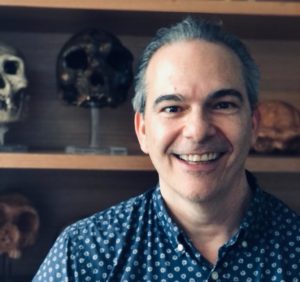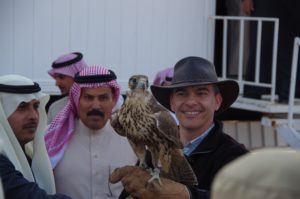A childhood intrigue of Egyptian cultural history and the origins of our species has led archaeologist Professor Michael Petraglia on incredible journeys to captivating locations throughout his career.
The enduring mission shared by many archaeologists to answer the many unsolved mysteries of human evolution is one shared by Professor Petraglia, and he’ll continue to do so in his new role at Griffith University.
As the new Director of Griffith’s Australian Research Centre for Human Evolution (ARCHE), Professor Petraglia hopes to assist in providing the same opportunities he has enjoyed all over the world.
Founded in 2016 by former Director Professor Rainer Grün, ARCHE has been responsible for major archaeological discoveries that have rewritten or posed new questions regarding ancient human migrations and cultural practises among different hominin species. These discoveries include the world’s oldest known cave art found, and the discovery of ancestors of Homo floresiensis, aka the ‘hobbit’.
Notwithstanding the international profile that ARCHE has garnered from such discoveries and more, a growing focus on the study of Australia and the Asia-Pacific is a goal that Professor Petraglia said was consistent with Griffith’s mission.
Origin of fascination

ARCHE’s new Director Professor Michael Petraglia.
Growing up, a burning interest in the sandy landscapes of Ancient Egypt and the history and culture of its people was fostered by Professor Petraglia’s family, so much so that it set him on course to becoming a renowned leader in the field of archaeology globally.
“As long as I can remember, I wanted to be an archaeologist. At first I was obsessed with Egyptian cultural history, but in my teenage years I became increasingly interested in human evolution, and was glued to the book, Origins by Richard Leakey and Roger Lewin,” Professor Petraglia said.
“As a child I was fascinated by archaeology and archaeological discoveries. My mother was always supportive of me in pursuing my interests, and happy to buy me loads of books on the subject. My older sister Maria supported my dreams during my teenage and undergraduate years — taking me to museums and buying tickets to go see talks by some of the most famous personalities involved in the study of us and our evolution, such as Margaret Mead, Richard Leakey, and Jane Goodall.”
Professor Petraglia’s undergraduate years were spent at New York University in the heart of Manhattan, which provided him with the opportunity to volunteer at the American Museum of Natural History.
Graduate school at the University of New Mexico, in Albuquerque followed, where he was drawn to the teachings of Lewis Binford, the father of ‘new archaeology’. Here, Professor Petraglia obtained his MA and PhD degrees.
Lessons from the past
Going on to work for various institutions around the world — Cambridge University, Oxford University, the Human Origins Program at the Smithsonian Institution and the Max Planck Institute for the Science of Human History — has given Professor Petraglia a wealth of insights into ancient cultures and the conditions early human faced in different parts of the world at different times.
“The world-wide migration of our species, Homo sapiens, is one of the most important events in human evolutionary history,” he said.
“The consensus view was that human populations migrated out of Africa once, 60,000 years ago, moving swiftly along the coastlines to eventually reach Australia.
“Thanks, in part, to our research, this model no longer holds sway, and instead has been replaced by a more complex model which indicates multiple migrations out of Africa, and over a longer period of time, stretching back to 200,000 years ago, including the mixing and mating with our close relatives, the Neanderthals and Denisovans.”

A memorable moment during a field trip in Saudi Arabia.
It was Professor Petraglia’s work in Arabia that helped shape his views about how climatic change has influenced human demography and societal responses over the long term.
“Twelve years of research has shown that Arabia had savanna ecosystems, and up to 10,000 lakes in the past, attracting human populations over time as shown by abundant archaeological and fossil evidence,” he said.
“These wet periods were followed by arid periods, which led to regional abandonments and extinctions. This repeated cycle of wetting and drying over the last 500,000 years influenced human migrations and societal responses.
“I am convinced that lessons from the past can help us better appreciate the impact of climate change on societies today.”
Vision for ARCHE
As Professor Petraglia takes the helm at ARCHE, he is already building stronger research and teaching relationships across Griffith and its researchers in various schools and centres, as well as making plans to bolster relations with colleagues at nearby institutions such as the University of Queensland and the Queensland Museum.
With plans to maintain his research affiliations with the Smithsonian Institution and the Max Planck Institute and existing partnerships with scientists in Europe, Africa and Asia, Professor Petraglia envisages an increase in ARCHE’s research collaborations.
“But the history of the Indigenous peoples of Australia has always fascinated me and I am looking forward to learning more about their cultures and their views about the archaeology of the continent,” he said.
“The landscapes and environments of Australia from tropical forests to deserts are of great interest — so I would like to learn more about how these ecosystems are both different from, and similar to, the places that I have worked in around the world.”

